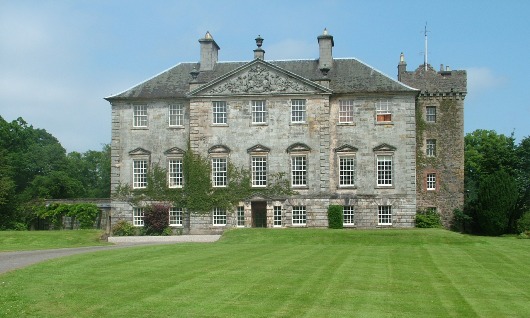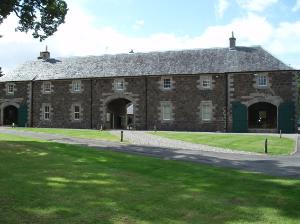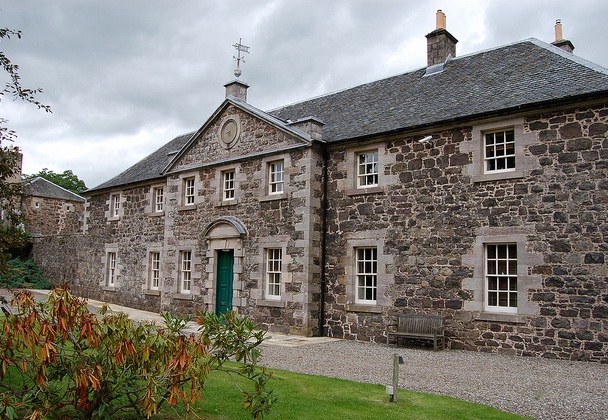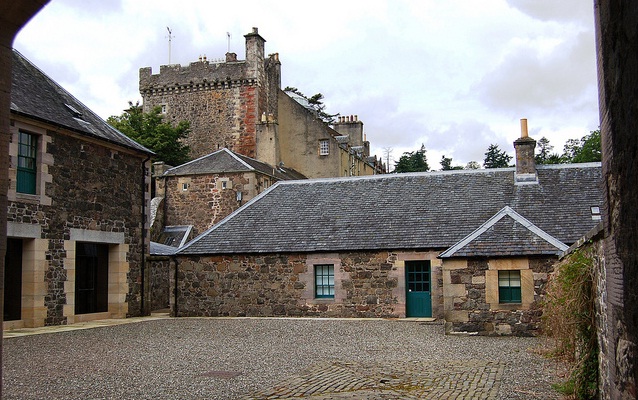|
 Until 1408, The Lairds of Touch were Frasers.
The estate was acquired by a branch of the Setons in Aberdeen, by
second
son of Alexander Seton, 1st Earl of Huntly, and the tower is thought to have been
built in the 15th Century. Originally it would have been larger and
there would have been no windows on the ground floor. Until 1408, The Lairds of Touch were Frasers.
The estate was acquired by a branch of the Setons in Aberdeen, by
second
son of Alexander Seton, 1st Earl of Huntly, and the tower is thought to have been
built in the 15th Century. Originally it would have been larger and
there would have been no windows on the ground floor.
In the 16th Century, part of the tower was
pulled down and the house extended to make a more substantial,
fortified house. The North side of the top floor was added in the
17th Century.
Construction of the South front was started
in 1758 and the plans may have been prepared by William Adam,
although there is no record of this. The oval staircase is a
brilliant design that might well have been the work of William's
son, Robert Adam. The Buchanans, became owners of the estate in 1928
but the Seton coat of arms can still be seen on the pediment of the
South front.
The Setons of Touch were supporters of the
Jacobites and were the Hereditary Armour Bearers for the Scottish
Kings. In 1745, on his way to the Battle of Prestonpans, Prince
Charles Edward Stuart stayed at Touch. When fleeing after Culloden,
he is said to have found refuge in the cave under the waterfall in
Touch Glen. It would have been far too dangerous to stay in the
house with Seton's Jacobite sympathies well known.
The old road from Stirling to Glasgow passed
within 200 yards of the front of Touch House and until the middle of
the 18th Century, the road skirted an impassable swamp. After the
failed '45 Rebellion, Hugh Seton and other local lairds, brought
families down from the Highlands to work on the mammoth task of
draining the Carse of Stirling. Ditches were dug to float the peat
from this bogland down to the River Forth and eventually out to sea.
Around 60 square miles were reclaimed, exposing rich, clay soil
beneath.
The estate covers 4,500 acres of woodland
and farms. The 5 carse farms were created after the reclamation in
the 18th Century. The walled garden and the woodland garden contain
over 150 different species of rhododendrons and azaleas, as well as
many other interesting trees, shrubs and herbaceous plants. Forth
Valley Orienteers, the Boy Scouts and the army use the estate and
there are occasional guided walks with the Countryside Rangers. The
public are welcome to make use of the the estate and Touch House has
been open to the public on Doors Open Days.
It is
a reasonable assumption that the first building at Touch would have
been a tower. It would have been built of wood, for until the 15th
century fortified stone buildings which could be used as a
stronghold were forbidden unless they belonged to the King. The
tower, which exists today is thought to have been built in the 15th
century and probably built in a least two periods. Originally it
would have been larger, and of course had no windows on the ground
floor.
 The Lairds of Touch
had long been Frasers until in 1408, when it was
acquired by the Setons, who extended the house, pulling down
part of the tower to make a more substantial although still
fortified house. The Lairds of Touch
had long been Frasers until in 1408, when it was
acquired by the Setons, who extended the house, pulling down
part of the tower to make a more substantial although still
fortified house.
In 1745
Prince Charles Edward, on his way to the Battle of Prestonpans
stayed at Touch on the night of September 13th 1745. He gave to his
host a quaich, a ring and a miniature and General Murray left behind
his dispatch book. These were much treasured by the Setons, and are
now held in the safekeeping of an Edinburgh Museum. Later, fleeing
from his Hanoverian pursuers after Culloden, he is said to have
found refuge in a cave under a waterfall in the Touch Glen, for,
with Setonís sympathies well known, the house itself would have been
too dangerous.
Hugh
Seton, together with local lairds, brought families down from the
highlands to start the mammoth task of draining the Carse of
Stirling. Ditches were dug to float the peat which covered this
bogland down to the River Forth, and eventually out to sea. In all
an area some 60 square miles was reclaimed, and the rich clay soil
which was exposed beneath is now renowned for the production of
Timothy hay.
This was only
the start of Hugh Setonís improvements to Touch. It is to him that
we owe the magnificent south front which was commenced in 1757 and
continued till 1770 when the Drawing Room ceiling was completed. As
a result of his expenditure Hugh Seton found himself in considerable
debt and left to travel abroad. His son, Archibald, determined to
clear the estate of debt, joined the East India Company and sailed
to India in 1779. He rose to high office, accumulated a considerable
sum of money but sadly died on his way home before reaching Touch on
whose behalf he has worked all his life.
The 18th Century Additions
 The
south front was commenced in 1758, and has traditionally been
attributed to the Adam family, although to date there is no certain
proof of this. It seems that the Master Mason, Gideon Gray
supervised the construction of the 1748 design. The only major
difference between the present house and those plans is in the
staircase, which in the plans was shown as a square and not an oval.
A stair of such a brilliant design might well have been the work of
William Adam's son, Robert, but that remains a mystery. The
south front was commenced in 1758, and has traditionally been
attributed to the Adam family, although to date there is no certain
proof of this. It seems that the Master Mason, Gideon Gray
supervised the construction of the 1748 design. The only major
difference between the present house and those plans is in the
staircase, which in the plans was shown as a square and not an oval.
A stair of such a brilliant design might well have been the work of
William Adam's son, Robert, but that remains a mystery.
The
stone for the front of the house and for the stairs came from
Longannet quarries. It was carried by sailing brigs up the Forth and
then by horse and cart out from Stirling. David Henderson of
Clackmannan was the glazier, and the hot water boiler was supplied
by the newly founded Carron Iron Works with strict instructions not
to fill the boiler with cold water, and that "Gentlemen found it
convenient to pay their account by return!".
Archibald's sister, Barbara, married Sir Henry Stuart of
Allanton, and inherited the estate. Sir Henry was a well known
aboriculturist and planted many of the fine trees on Touch. He took
the name of Seton-Steuart and their family remained the lairds of
Touch until it passed to the present owners, the Buchanans in
1928.
Charles
Buchanan engaged Sir Robert Lorimer to make improvements such as the
installation of bathrooms, heating and lighting in the house, and
the replacement of the original windows in place of the plate glass
introduced in the Victorian era. Lorimer carried out this work with
great sympathy. His one structural alteration was to remove what had
been the wall on the left as you enter the hall, and this gives a
feeling of spaciousness and light to what must have been a rather
gloomy entrance.
Historical notes provided
courtesy of the Touch Estate
Notes about the history of the
Seton's of Touch and the house and gardens from the Historic
Scotland website:
 Historical influences on the designed
landscape Historical influences on the designed
landscape
The Setons were a powerful Scottish family
who, in return for their loyalty to the Crown, were created Barons
of Seton in 1361 and Earls of Winton in 1585. Alexander Seton, head
of a cadet branch of the family acquired Touch in the mid-15th
century from the Fraser family but it was his son, of the same name,
who became the 1st laird of Touch in 1480.
Sir Alexander's grandson,
Sir Walter Seton, the 2nd laird, was the first to actually inhabit
the property before his death in 1568. When the first Setons lived
in Touch it was principally a tower, reputedly built by the previous
owners in the 14th century.
In 1742, Elizabeth Seton inherited the
property from her brother and, just before her marriage to Hugh
Smith on the day of the Battle of Prestonpans, she allowed Prince
Charles to stay at Touch. After their marriage Hugh and Elizabeth
Seton, having retained the family name, commissioned a new house
adjoining the original tower. Money was borrowed to cover the cost
of the building and considerable improvements were made to the
grounds.
John Ramsay of Ochtertyre described the improvements at
Touch as being of a scale similar to those being carried out at the
same time by Hugh Seton's friend, Lord Kames, at Blair Drummond. The
architect of the house is uncertain but it is known that Gideon Gray
was the stonemason for the works and was retained thereafter as
factor for the estate.
Elizabeth Seton died in 1775. Hugh Seton
continued to borrow money and amassed debts which resulted in his
imprisonment at Dover Castle. On his release, he changed his name
and left the country. His son, Archibald, had gone to India in 1779
where he joined the East India Company and achieved considerable
success, eventually becoming a member of the Council. Through his
efforts the financial fortunes of Touch were redressed.
In Archibald
Seton's absence, Touch was managed by his brother-in-law, Sir Henry
Seton-Steuart of Allanton. It was during this period that the
designed landscape which remains today was established. Thomas White
was commissioned in 1779 to prepare an improvement plan but,
according to the survey plan of 1810 by Leslie, only some of this
appears to have been carried out. Sir Henry is said to have planted
about one million trees at Touch and many of these were established
on Craigbrock Hill to the west of the house which roughly accords
with White's ideas. His suggestions for clump planting as part of an
extensive scheme for informalising the park were not all taken up
and his plans for a serpentine lake to the east of the house appear
to have been dismissed.
In 1818, Archibald Seton died and the
estate passed to his sister Barbara. In 1835 it passed to her niece,
Elizabeth, daughter of Sir Henry Seton-Steuart, and in 1866 to her
son Sir Henry James Seton-Steuart. Little appears to have been
altered on the estate during their time although some ornamental
conifers were planted in the manner of this period.
Sir Henry Allan Seton-Steuart inherited in
1884. He lived at Allanton, and Touch was let. His younger brother,
Douglas, the last Seton baronet, sold Touch to Mr C.A. Buchanan in
1928. The new owner commissioned Sir Robert Lorimer to restore the
interior of the house. Lorimer also designed a new lodge and
realigned the approach drive to the house.
During World War II, Touch was used as a
convalescent home. After 1945 the family returned and, since 1962,
their son and daughter-in-law, Mr ∓ Mrs P.B. Buchanan have lived
at Touch. The gales of the winter of 1968 caused severe damage to
the woodlands and recovery has been slow but Mr ∓ Mrs Buchanan
continue their series of improvements, particularly in the garden.
The designed landscape at Touch is managed
by the estate.
The parks are farmed but features of the original
design such as the roundels within them have been retained. The
woodlands suffered badly from the 1968 gales and recovery has been
slow. Features such as the hedgerows on the edge of the woodland on
the northern boundary are breaking down due to the difficulty of
maintaining them mechanically. The gardens have been subject to
continual improvement since 1962.
| 
